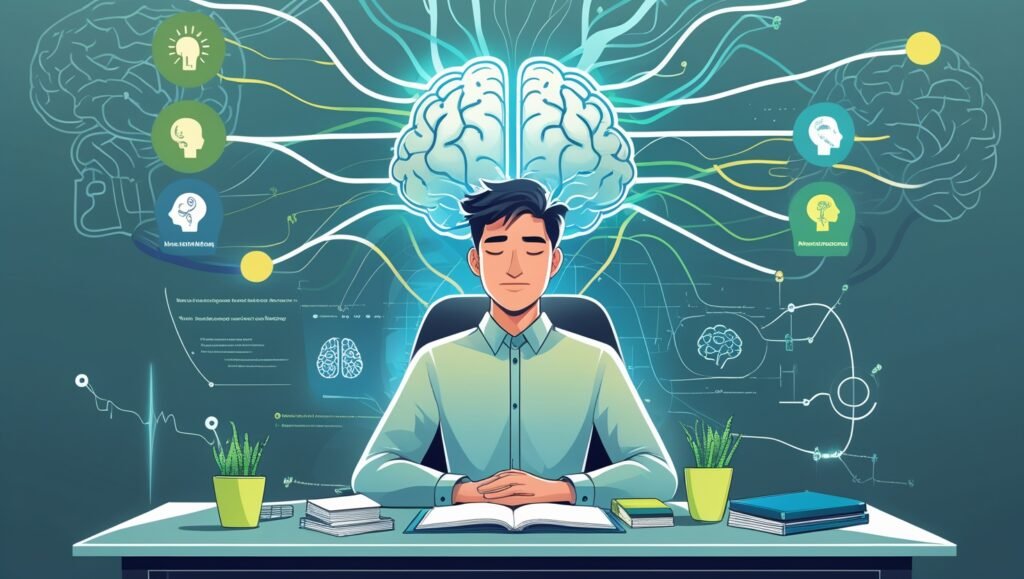Neuro-Linguistic Programming for students, stress management techniques, student mental health, NLP techniques for stress

1. Introduction
- Student Stress and Its Impact on Academic Performance and Mental Health
Student stress is a growing concern, affecting both academic performance and overall well-being. High expectations, tight deadlines, and exam pressure can lead to anxiety, burnout, and reduced concentration, making it difficult to achieve academic success. Managing stress effectively is crucial for maintaining mental clarity and productivity.
- Neuro-Linguistic Programming (NLP) for Stress Management
Neuro-Linguistic Programming (NLP) is a powerful technique that helps individuals reframe negative thoughts, manage emotions, and enhance focus. By understanding the connection between language, thoughts, and behavior, students can develop a positive mindset and reduce stress effectively.
- What This Blog Covers
In this blog, we will explore practical NLP strategies that students can use to manage stress, improve focus, and enhance overall academic performance. Whether you’re preparing for exams or handling daily academic challenges, these techniques will help you stay calm, confident, and in control.
2. Understanding Stress in Students
Student stress is often triggered by exams, tight deadlines, peer pressure, and academic expectations. These stressors can negatively affect focus, memory, and overall well-being, leading to anxiety, fatigue, and poor academic performance.
While traditional stress management techniques like relaxation exercises and time management help, they don’t always address the root cause of stress—negative thought patterns. This is where innovative approaches like Neuro-Linguistic Programming (NLP) can be more effective in rewiring the mind for resilience and success.
3 NLP Techniques to Reduce Stress for Students
3.1 Reframing Negative Thoughts
Overcoming student stress starts with reframing negative thoughts into positive, solution-focused ones. Neuro-Linguistic Programming (NLP) techniques, such as visualization, positive affirmations, and anchoring, help students replace anxiety with confidence and clarity.
By focusing on solutions instead of problems, students can boost their motivation, improve concentration, and handle academic challenges with ease. A shift in mindset leads to better stress management, improved performance, and overall well-being.
Example: Replacing “I’ll fail this test” with “I am prepared and will do my best.”
3.2. Anchoring Positive Emotions
Anchoring is an NLP technique that helps you recall positive emotions by associating them with a physical action.
Step-by-Step Guide:
- Recall a time when you felt calm and confident.
- Intensify the feeling by reliving the moment.
- Choose a physical anchor (e.g., touching your thumb and index finger together).
- Activate the anchor each time you experience calmness.
- Use the anchor before exams to trigger relaxation.
Benefit: This technique helps reduce anxiety and boosts confidence during stressful situations like exams.
3.3. Visualization for Success
Guided mental imagery can help reduce stress by mentally preparing for success.
Example:
Before an exam or presentation, close your eyes and visualize yourself:
Walking into the room with confidence.
Answering questions calmly and correctly.
Feeling relaxed and in control.
Benefit: This primes your brain for success and reduces fear of failure.
3.4. The Swish Pattern for Overcoming Stressful Thoughts
The Swish Pattern is an NLP technique that replaces negative mental images with positive ones.
- Identify a stressful image (e.g., failing an exam).
- Create a positive image (e.g., celebrating success).
- Mentally shrink the negative image and fade it away.
- Make the positive image bigger and brighter.
- Repeat until the negative thought no longer triggers stress.
Benefit: This rewires your brain to focus on success rather than fear.
3.5. The Power of Affirmations and Self-Talk
Positive self-talk can shift your mindset from stress to confidence.
Examples of Stress-Reducing Affirmations:
“I am prepared and capable.”
“I stay calm and focused under pressure.”
“Every challenge is an opportunity to grow.”
Benefit: Repeating affirmations daily rewires your brain for a positive outlook.
3.6. NLP Breathing & Relaxation Techniques
Breathing techniques can regulate stress responses and improve focus.
Simple Exercise:
- Inhale deeply for 4 seconds.
- Hold for 4 seconds.
- Exhale slowly for 6 seconds.
- Repeat for a few minutes before an exam.
Benefit: This calms the nervous system and enhances concentration.
By practicing these NLP techniques, students can manage stress effectively and perform at their best in exams.
4. Additional Benefits of NLP for Students
Improved Focus and Concentration
NLP techniques like visualization, anchoring, and breathing exercises help sharpen focus and eliminate distractions. Practicing mindful breathing and mental rehearsal before studying enhances concentration and productivity.
Quick Tip:
Try the Pomodoro Technique—study for 25 minutes, take a 5-minute break, and repeat.
Better Emotional Resilience and Confidence
Using positive affirmations and the Swish Pattern, students can replace self-doubt with confidence. NLP helps in managing exam anxiety and building resilience against stress.
Example Affirmation:
“I am calm, focused, and ready to succeed.”
Enhanced Learning and Memory Retention
NLP-based mnemonics, association techniques, and visualization improve memory recall. Creating mental connections between information makes learning faster and more effective.
Memory Hack:
Use the “Memory Palace” technique—associate information with familiar locations for better recall.
By applying these NLP strategies, students can boost academic performance, reduce stress, and enhance learning efficiency..
5. Practical Tips for Applying NLP in Daily Student Life
NLP techniques can improve focus, memory, and confidence when included in daily study habits.
How to Use NLP in Studying:
Morning Affirmations: Start your day with positive self-talk (e.g., “I absorb new information easily.”).
Visualization: Before studying, imagine yourself understanding and remembering concepts effortlessly.
Anchoring Technique: Associate a physical gesture (e.g., touching your thumb and index finger) with a focused, calm state. Use it before exams or study sessions.
The Swish Pattern: Replace distracting thoughts with a mental image of success.
Quick NLP Exercises for Instant Stress Relief
When feeling overwhelmed, these NLP techniques can help:
1. 4-7-8 Breathing Technique
Inhale for 4 seconds, hold for 7 seconds, exhale slowly for 8 seconds.
Calms the nervous system and sharpens focus.
2. Instant Confidence Anchor
Recall a moment of success, intensify the feeling, and press your thumb and forefinger together.
Use this anchor before tests or presentations.
3. Rapid Eye Movement Reset
Move your eyes side to side for 30 seconds to reduce anxiety and reset focus.
By integrating NLP into your study routine, you can enhance learning, memory, and stress management, leading to better academic performance.
6. Conclusion
These are Some of the Techniques That Can help Students To reduce Stress and Anxiety For Personal Coaching For students contact Here

